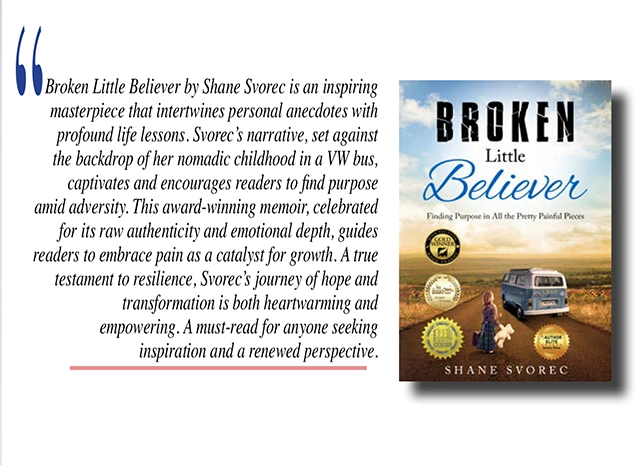Shares How Life’s Journey Shapes Stories of Empathy and Resilience
Shane Svorec discusses how her transient upbringing, personal challenges, and advocacy work shape her writing, creating stories that foster empathy, resilience, and appreciation for life’s simple joys.
Shane Svorec’s journey as a writer is deeply intertwined with her rich and varied life experiences. Her childhood, marked by constant movement across the country, instilled in her a unique perspective that she channels into her writing. In our interview, Shane discusses how her transient upbringing influenced her narratives, especially in Broken Little Believer. She reveals how these experiences fostered adaptability and an appreciation for diversity, elements that are vividly reflected in her literary work.
In Broken Little Believer, Shane’s personal journey of finding purpose through pain is a poignant exploration of resilience and hope. She opens up about the motivations behind turning her life experiences into a memoir and how the process of writing became a profound tool for healing and self-discovery. Her story is a testament to the strength derived from faith and the relentless pursuit of meaning amidst adversity.
As an independent youth turned foster parent, Shane brings a deeply personal understanding to her advocacy work. Her experiences inform not only her storytelling but also her commitment to fostering resilience and empathy. Shane’s insights into the foster system highlight the importance of empathy and support, driving home the message that our origins do not dictate our destiny.
Shane’s second book, The Busy Bridge That Got Its Break, personifies the Tappan Zee Bridge to tell a heartwarming story that resonates with readers of all ages. Drawing inspiration from her childhood memories, Shane uses the bridge as a metaphor for overlooked individuals who, like the bridge, carry heavy burdens unnoticed. This narrative encourages readers to slow down and appreciate the often-overlooked beauty and struggles around us.
Describing herself as having the heart of a hippie and the faith of a missionary, Shane’s identity manifests vividly in her writing. Her free-spirited love for nature and deep-seated faith shine through, inspiring readers to savor the simple joys of life and approach each day with gratitude and intention. Her works serve as a reminder to pause, appreciate, and connect with the world around us.
Shane’s involvement in her community and work in mental health and crisis intervention significantly influence the themes and characters in her books. Her real-world experiences bring authenticity and depth to her writing, allowing her to craft narratives that resonate deeply with readers. Shane’s commitment to advocacy and her dedication to uplifting others are evident in every page she writes, making her stories not only compelling but also profoundly impactful.
Through our conversation, it’s clear that Shane Svorec’s writing is a reflection of her life—rich with experiences, grounded in empathy, and driven by a desire to connect and inspire. Her stories encourage readers to embrace their journeys, find strength in their struggles, and always hold onto hope.

Your upbringing involved traveling across the country and living in numerous places. How has this transient lifestyle influenced your perspective on life, and how does it shape the narratives in your writing, particularly in ‘Broken Little Believer?
Moving as frequently as I did as a child and growing up in so many areas, my perspective was formed with the belief that every encounter and experience can be an opportunity to meet someone special or learn something valuable. Similar to the many places I’ve lived, my perspective grew broad and flexible. I looked for the beauty in people and places and found appreciation in differences. I learned to be adaptive, outgoing, and patient. As a writer, my upbringing shaped the narratives found in my writing as I strive to use words to paint a picture, offer understanding, and find points of connection. I capture life through the lens of many people and different points of view. I feel an obligation to use my words to create literary works that bring people together and provide a platform for discussion, needed awareness, and greater empathy.
In Broken Little Believer, you share your personal journey of finding purpose through pain. What motivated you to turn your life experiences into a book, and how did the process of writing this memoir impact your healing and self-discovery?
As a little girl, whenever something bad happened, I would tell myself there had to be a reason or purpose. I would have crumbled without this habitual internal dialogue and my reliance on faith. We don’t survive tragedies if we don’t have hope for the future. Without much support, I knew I had to be strong and push myself to keep going. I came to expect that I had to do it alone, and that created a fire within me that I knew I needed to keep lit. As I gained hindsight, I came to see some of the purposes for my pain, and this knowledge reinforced my beliefs. We all endure hardships at some time or another in our lives, but what we do with the pain and how we choose to live our lives, regardless of it, is a choice we all get to make.
When I faced my own mortality, I knew that the book everyone told me I should write for years couldn’t be put off any longer. Tomorrow is not promised to anyone, so I am a proponent of living life and pursuing your dreams now.
As someone who has been both a foster child and a foster parent, how do these experiences inform your advocacy work and the stories you tell? Are there specific messages you hope to convey about resilience and empathy to readers?
Wow! What a great question. My awareness and personal experiences of the foster system motivated me to want to help others. I understood the gaps and limitations of the system and also recognized opportunities to further support those who needed it. When you live through something, you develop greater empathy and understanding. I try to lead by example and use my experiences to form connections rooted in wisdom, patience, and first-hand knowledge. Where we come from or what we endure does not dictate where we go or who we become. I firmly believe that when we know better, we do better.
Your book, The Busy Bridge That Got Its Break, personifies a bridge to tell a heartwarming story. What inspired you to write about the Tappan Zee Bridge in this way, and what do you hope readers of all ages take away from this story?
The Tappan Zee Bridge was the backdrop for many of my young memories as a little girl. From my classroom window, I could see the bridge. What always looked like a smile to me because of the way it was designed created within me an endearing affection for the bridge. I would get lost staring at it while noticing that the bridge always had vehicles on it day and night. As a child, I wondered when the bridge got a break. As an adult, I viewed the bridge differently but still with affection. As I got older, so did the bridge, and many people wanted to tear it down. The bridge carried much more weight than it was designed to, and it started to break down and look tired. I began to compare people and this “smiling” structure. Like many people, it carried a heavy weight and went unnoticed until a break occurred. Signs were hung from the bridge to prevent people from making permanent decisions in moments of desperation, and emergency phone boxes were placed on the longest bridge in NY should someone in distress need to hear a caring voice. The more I thought about this “smiling” bridge that went unnoticed, the more I drew a parallel between it and the many overlooked people who traveled on it. I wrote this book as a tribute to the bridge, its history, and the lessons it taught me – especially the importance of slowing down to appreciate and value the people, places, and structures around us that often go unnoticed.
You describe yourself as having the heart of a hippie and the faith of a missionary. How do these aspects of your identity manifest in your writing, and how do they help you connect with and inspire your readers?
I am a free-spirited person who loves nature and the everyday beauty of the world. I live with intention and make time to stop and notice things. I am open-minded, a bit of a romantic, and a deep thinker. My zest for life and appreciation for the little things help inspire others to do the same. We live in a busy world, and we are so distracted in our daily lives. I believe my approach to celebrating little moments and savoring simple gifts prompts others to slow down, take a breath, and practice gratitude. When we look at life through a lens of appreciation, we find more things to be grateful for.
As an active member of your community and someone involved in mental health and crisis intervention, how do your real-world experiences and interactions influence the themes and characters in your books? Are there specific stories or lessons from your community work that have found their way into your writing?
I am a cheerleader for the underdog, an advocate for the misunderstood, and a spokesperson for those without a voice. My experiences and awareness of various life challenges have shaped me and fueled my motivation to serve in a way that helps others. I believe we all have strengths, gifts, and talents that can (and should) be used to make a positive difference in the world. Knowing that I can use my own experiences for good and support positive change is gratifying, but it’s an obligation we all owe to humanity. We were designed to connect with one another and experience a sense of belonging, value, and purpose. My writing takes many personal and vulnerable experiences and turns them into opportunities to learn and grow from. As a result, my writing encourages others to be true to themselves and unashamed of their pain or past experiences. This is how we live genuinely and lead healthy and fulfilling lives.



